475. The last right ascension day in
the life of
Epimenides
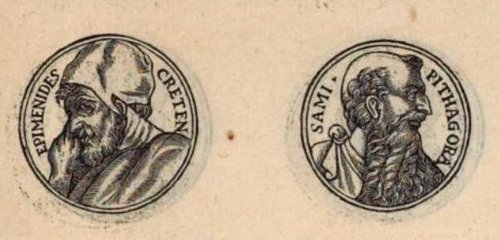
could possibly have coincided with the
first glyph on side b of the C tablet, i.e. to the First Point of
Aries (<) which in Roman times had been at Sheratan:
 |
98 |
 |
56 |
zero (393) |
|
Ca9-9 (237) |
kua moe |
|
314 / 2 =
157 |
... The
original story was by Diogenes Laertius, an
Epicurean philosopher circa early half third
century, in his book On the Lives, Opinions, and
Sayings of Famous Philosophers. The story is in
Chapter ten in his section on the Seven Sages, who
were the precursors to the first philosophers. The
sage was Epimenides. Apparently Epimenides went to
sleep in a cave for fifty-seven years. But
unfortunately, 'he became old in as many days as he
had slept years'. Although according to the
different sources that Diogenes relates, Epimenides
lived to be one hundred and fifty-seven years, two
hundred and ninety-nine years, or one hundred and
fifty-four years.
A
similar story is told of the Seven Sleepers of
Ephesus, Christian
saints
who fall asleep in a cave while avoiding Roman
persecution, and awake more than a century later to
find that Christianity has become the religion of
the
Empire
...
However,
the Full Moon was at the
opposite side of the
year and the first
Chinese station was at
the pair Spica and Heze,
which raises doubts. For
instance could the last
glyph before number 378
(→ Saturn) at vero
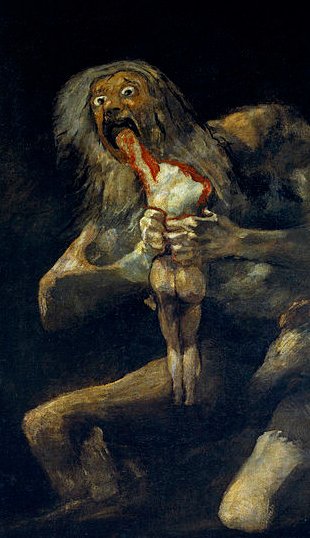
have
corresponded to the last
day when Epimenides was
alive. 377 = 393 - 16 =
220 + 157 and this was
where the Wolf (Upwaut,
Fenrir) was
ruling
(rose heliacally):
| te kihikihi |
o te henua - kua haga hia |
kua pua |
te vero |
te henua |
kiore - te henua |
|
Pua. 1. A zingiberacea (plant of which few specimens are left on the island). 2. Flower: pua ti, ti flower, pua taro, taro flower, pua maúku pasture flower; pua nakonako, a plant which grows on steep slopes and produce red, edible berries. 3. Pua tariga (or perhaps pu'a tariga), anciently, hoops put in earlobes. 4. The nanue fish when young and tender. Puapua, summit, top, upper part; te puapua o te maúga, the top of the mountain; te puapua kupega, the upper part of a fishing net. Vanaga. Pu'a. 1. (Modern form of pu'o), to cover up something or oneself, to put on; ka-pu'a te ha'u, put on your hat; ka-pu'a-mai te nua, cover me up with a blanket. 2. To respond to the song of the first group of singers; to sing the antistrophe; he-pu'a te tai. 3. To help; ka-pu'a toou rima ki a Timo ite aga, help Timothy with the work. 4. Pu'a-hare, to help a relative in war or in any need; ka-oho, ka-pu'a-hare korua, ko ga kope, go, give your relative a hand, lads. 5. To speak out in someone's favour; e pu'a-mai toou re'o kia au, speak in my favour, intercede for me. Pu'apu'a, to hit, to beat. Vanaga. 1. Flower, ginger, soap; pua mouku, grass. 2. To grease, to coat with tar, to pitch; pua ei meamea, to make yellow. Puapua, a piece of cloth. Mgv.: pua, a flower, turmeric, starchy matter of the turmeric and hence soap. Mq.: pua, a flower, soap. Ta.: pua, id. Ma.: puapua, cloth wrapped about the arm. Churchill. |
 |
 |
 |
 |
 |
 |
| *Ca14-12 (366 + 9) |
*Ca14-13 → 182 |
*Ca14-14 (393 - 16) |
*Ca14-15 (378) |
*Ca14-16 |
*Ca14-17 (396 - 16) |
|
... The ordinary year in the previous Roman calendar consisted of 12 months, for a total of 355 days. In addition, a 27-day intercalary month, the Mensis Intercalaris, was sometimes inserted between February and March. This intercalary month was formed by inserting 22 days after the first 23 or 24 days of February; the last five days of February, which counted down toward the start of March, became the last five days of Intercalaris. The net effect was to add 22 or 23 days to the year, forming an intercalary year of 377 or 378 days ... |
| CLOSE TO THE FULL MOON: |
|
ξ Phoenicis (9.0), ρ Tucanae (9.1), DENEB KAITOS (Tail of the Sea Beast) = β Ceti, η Phoenicis (9.4), AL NITHĀM (String of Pearls) = φ¹ Ceti (9.6)
*334 = *375.4 - *41.4 |
ACHIRD (Woman with Luminous Rays) = η Cassiopeiae (10.7) |
Legs-15 (Wolf)
ν Andromedae (11.0), φ² Ceti (11.1), ρ Phoenicis (11.2), η Andromedae (11.4)
*336 = *377.4 - *41.4 |
CIH (Whip) = γ Cassiopeiae, λ Tucanae (12.4), φ³ Ceti (12.6), μ Andromedae (12.8)
*12.4 + *366 -*41.4 = *337 |
φ4 Ceti (13.2) |
no star listed (14) |
|
... The king, wearing now a short, stiff archaic mantle, walks in a grave and stately manner to the sanctuary of the wolf-god Upwaut, the 'Opener of the Way', where he anoints the sacred standard and, preceded by this, marches to the palace chapel, into which he disappears. A period of time elapses during which the pharaoh is no longer manifest. When he reappears he is clothed as in the Narmer palette, wearing the kilt with Hathor belt and bull's tail attatched. In his right hand he holds the flail scepter and in his left, instead of the usual crook of the Good Shepherd, an object resembling a small scroll, called the Will, the House Document, or Secret of the Two Partners, which he exhibits in triumph, proclaiming to all in attendance that it was given him by his dead father Osiris, in the presence of the earth-god Geb. 'I have run', he cries, 'holding the Secret of the Two Partners, the Will that my father has given me before Geb. I have passed through the land and touched the four sides of it. I traverse it as I desire.'
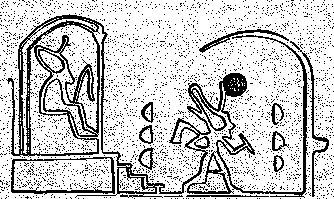
|
|
... The month, which takes its name from Juppiter the oak-god, begins on June 10th and ends of July 7th. Midway comes St. John's Day, June 24th, the day on which the oak-king was sacrificially burned alive. The Celtic year was divided into two halves with the second half beginning in July, apparently after a seven-day wake, or funeral feast, in the oak-king's honour ...

|
| te honu paka |
te henua |
honu kau |
te mata |
te honu |
kua heheu |
|
Paka. 1. Dry; to become dry (of things); pakapaka, to dry out. Te paka is also the name of the moss-covered areas, between the small lakes of volcano Rano Kau, through which one can pass without getting one's feet wet. 2. To go, to depart; he-paka-mai, to come; he-oho, he-paka, they go away. 3. To become calm (of the sea): ku-paka-á te tai. Pakahera, skull, shell, cranium; pakahera puoko tagata, human skull; pakahera pikea, shell of crab or crayfish. Gutu pakapaka, scabbed lips. Hau paka, fibres of the hauhau tree, which were first soaked in water, then dried to produce a strong thread. Moa gao verapaka, chicken with bald neck. Ariki Paka, certain collateral descendents of Hotu Matu'a, who exercised religious functions. Vanaga. 1. Crust, scab, scurf; paka rerere, cancer; pakapaka, crust, scabby. 2. Calm, still. 3. Intensive; vera paka, scorching hot; marego paka, bald; nunu paka, thin. 4. To arrive, to come. 5. To be eager. 6. To absorb. 7. Shin T. Pakahera, calabash, shell, jug. Pakahia, to clot, curdle, coagulate. Pakapaka, dry, arid, scorching hot, cooked too much, a desert, to fade away, to roast, a cake, active; toto pakapaka, coagulated blood; hakapakapaka, to dry, to broil, to toast. Pakahera pikea, shell of crab or crayfish. Churchill. |
 |
 |
 |
 |
 |
 |
| *Ca14-18 |
*Ca14-19 |
*Ca14-20 (77 + 306) |
(6 + 378) |
*Ca14-22 |
*Ca14-23 |
| CLOSE TO THE FULL MOON: |
| 5 (159 + 302) |
6 (462 - 366 = 96) |
April 7 |
8 |
9 (465) |
10 (100) |
| 9 (132 + 302) |
10 (435 - 366 = 69) |
'March 11 |
12 |
13 |
14 (73) → π |
| "Febr 23 (6 * 70) |
24 (462 - 41 = 421) |
25 |
26 |
27 (*345) |
28 (59 = 2 * 29½) |
| 31 (95 + 302) |
1 (398 - 366 = 32) |
FEBR 2 |
3 |
4 |
5 (100 - 64) |
|
... the Palenque scribes repeated Creation again and described it as 'it was made visible, the image at Lying-down-Sky, the First-Three-Stone-Place'. Then we learned that five hundred and forty-two days later (1.9.2 in the Maya system), Hun-Nal-Ye 'entered or became the sky' (och ta chan). This 'entering' event occurred on February 5, 3112 BC ... |
| DEC 7 |
8 |
9 |
10 |
(345 = 162 + 183) |
12 (*266) |
| 1h (15.2)
β Phoenicis (15.1), υ Phoenicis, ι Tucanae (15.6), η Ceti, ζ Phoenicis (15.7)
*79 + *302 - *366 = *15 |
Al Batn Al Hūt-26 (Belly of the Fish) / Revati-28 (Prosperous) / 1-iku (Field Measure)
MIRACH (Girdle) = β Andromedae, KEUN MAN MUN (Camp's South Gate) = φ Andromedae (16.0), ANUNITUM = τ Piscium (16.5), REVATI (Abundant) = ζ Piscium (16.9)
REGULUS (α Leonis) |
ν Phoenicis (17.4), κ Tucanae (17.6)
*342.0 = *383.4 - *41.4 |
no star listed (18) |
ADHIL (Garment's Train) = ξ Andromedae (19.3), θ Ceti (19.7) |
KSORA (Knee) = δ Cassiopeiae (20.1), ω Andromedae (20.6), γ Phoenicis (20.8) |
|
... Though Andromeda has its roots most firmly in the Greek tradition, a female figure in Andromeda's place appeared in Babylonian astronomy. The stars that make up Pisces and the middle portion of modern Andromeda formed a constellation representing a fertility goddess, sometimes named as Anunitum or the Lady of the Heavens ...
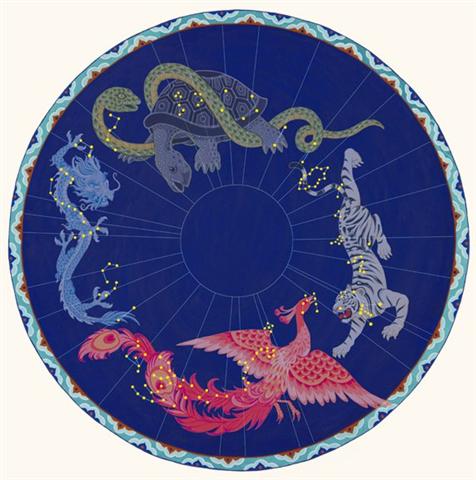
|
| CLOSE TO THE SUN: |
| 6 (342 + 302 - 365) |
7 (*200) |
8 (281) |
Oct 9 |
10 |
11 (284) |
| "Aug 26 |
27 |
28 (*80 * 2 = *160) |
29 (241 = 282 - 41) |
30 |
31 |
| JUNE 7 |
8 |
9 (*160 - *80 = *80) |
10 (161 = 241 - 80) |
11 |
12 |
| AL DAFĪRAH (Tuft) = β Com. Ber. (199.4) *158.0 = *199.4 - *41.4 |
σ Virginis (200.4)
*159.0 = *200.4 - *41.4 |
γ Hydrae (201.0), ι Centauri (201.4) *160.0 = *201.4 - *41.4 |
Al Simāk-12 (Lofty) / Chitra-14 (Bright One) / Horn-1 (Crocodile) / Sa-Sha-Shirū-20 (Virgin's Girdle) / ANA-ROTO-3 (Middle pillar)
MIZAR = ζ Ursae Majoris (202.4), SPICA = α Virginis, ALCOR = 80 Ursae Majoris (202.7)
SADALMELIK (α Aquarii)
*161.0 = *202.4 - 41.4 |
71 VIRGINIS (203.6) |
no star listed (204) |
 |
|
te henua |
te honu
kau |
manu kake
rua |
te henua |
te honu |
te rima |
|
Kake.
Kakea,
to come
near, to
embark. P
Pau.:
kake, to
climb, to
ascend.
Mgv.:
kake,
the arrival
of shoals of
spawning
fish. Mq.:
kake,
to climb up
a valley.
Ta.: ae,
to climb, to
ascend.
Churchill.
Mgv.:
kake, to
strike on an
ocean reef.
Ta.: ae,
to strand.
Churchill.
Sa.: a'e,
upward, to
go up;
sa'e, to
elevate one
leg, as in
the act of
falling in a
club match;
'a'e,
to ascend,
to rise.
To.: hake,
upward, to
ascend. Fu.:
ake,
up, to
ascend;
sake, ro
raise the
leg at one
in derision
or mockery;
kake,
to climb, to
ascend. Niuē:
hake,
up, going
up. Uvea:
ake,
up;
kake,
to go up.
Ma.:
ake,
upward;
kake,
to climb, to
ascend. Mq.:
ake,
on high,
upward;
kake,
to ascend.
Mgv.:
ake,
upward.
Bukabuka:
ake,
up. Ta.:
ae,
up, to go
up, to
ascend, to
climb. Ha.:
ae,
to raise, to
lift up, to
mount.
Fotuna:
no-jikijiake,
to lift up;
no-tukake,
to stand
upright.
Nukuoro:
kake,
to go up.
Nuguria:
kake,
up;
hanage,
northwest.
Rapanui:
kake a,
to go
abroad. Vi.:
thake,
upward;
thaketa,
to dig or
lift up.
Churchill 2. |
 |
 |
 |
 |
 |
 |
|
*Ca14-24 |
*Ca14-25 →
350 |
*Ca14-26 |
*Ca14-27
(390) |
*Ca14-28 |
*Ca14-29 |
|
CLOSE TO THE
FULL MOON: |
|
δ Phoenicis
(21.5)
*79 + *308 -
*366 = *21 |
PINWHEEL
GALAXY (M33
Trianguli)
(22.1), υ
Andromedae
(22.9) |
ACHERNAR
(End of the
River) = α
Eridani
(23.3), χ
Andromedae
(23.6), τ
Andromedae
(23.9) |
ALSEIPH
(Scimitar) =
φ Persei
(24.5), τ
Ceti (24.7) |
no star
listed (25) |
ANA-NIA-10
(Pillar-to-fish
by)
χ
Ceti (26.1),
POLARIS = α
Ursae
Minoris,
BATEN KAITOS
(Belly of
the Fish) =
ζ Ceti
(26.6),
METALLAH
(Triagle) =
α Trianguli
(26.9) |
 |
|
11 (159 +
308 - 366) |
April 12
(286 - 184) |
13 (468 =
365 + 103) |
14 (104 =
☼20) |
15 |
16 (392 -
366 + 80) |
|
"March 1
(60) |
2 |
3 |
4 (104 - 41
= 63) |
5 |
6 |
|
13 (347 =
164 + 183) |
DEC 14 |
15 |
16 |
17 |
18 (*272) |
|
ALSEIPH (Scimitar) = φ Persei |
|
October 15 |
288 |
*208 |
|
April 14 |
288 + 181 |
*390 |
|

... You are
the one who
shall stay
here. We, on
the other
hand, have
to turn
around.
Makoi
replied, All
right with
me! Then
Ira
continued to
speak to
Makoi:
Tomorrow,
when it
grows light,
set out and
name the
places
beginning
with
Apina.
Makoi
replied, How
shall I give
the names?
Again Ira
spoke, In
Hiva are
the names
that are to
be taken to
name (the
places of
the new
land). It
grew light
and Makoi
got up. He
set out and
came to
Apina.
When he
arrived
there, he
gave the
name This
is Apina
Iti, this is
Rapa Kura.
He went on
and came to
Hanga O
Ua. He
gave the
name This
is Hanga O
Ua of the
Beautiful
Wave (vave
renga).
Makoi
went on,
giving
names, until
he had made
a (complete)
circle
around both
sides (of
the island).
In Apina
Nui a
stone (maea)
was erected,
saying that
the naming
was done on
a (round)
trip during
a single day
...
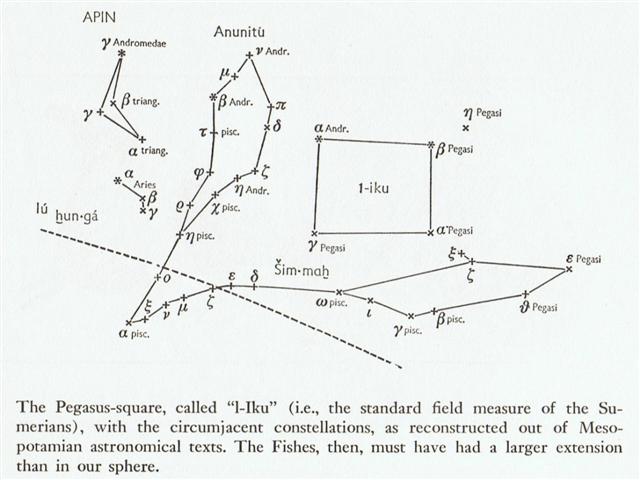 |
|
CLOSE TO THE
SUN: |
|
12 (342 +
308 - 365) |
Oct 13 (286) |
14 |
15 (288 =
☼204) |
16 |
17 (392 + 80
- 182) |
|
1 (244 = 285
- 41) |
Hora Nui 2 |
3 (*166) |
4 |
(☼164
=
☼84
+
☼80) |
6 |
|
JUNE 13
(164) |
14 (*85) |
15 (166) |
16 |
(☼84
=
☼164
-
☼80) |
18 (352 -
183) |
... Hotu's canoe sailed from Maori to Te Pito O Te Kainga. It sailed on the second day of September (hora nui) ... (E:74)
|
|
HEZE =
ζ
Virginis
(205.0),
Southern
Pinwheel
Galaxy = M83
Hydrae
(205.7) |
ε Centauri
(206.3), κ
Oct. (206.4)
*165.0 =
*206.4 -
*41.4 |
no star
listed (207) |
τ
Bootis
(208.2),
BENETNASH
(Leader of
the
Daughters of
the Bier) =
η
Ursae
Majoris
(208.5),
ν
Centauri
(208.7),
μ
Centauri,
υ
Bootis
(208.8) |
no star
listed (209) |
MUPHRID
(Solitary
Star) = η
Bootis
(210.1), ζ
Centauri
(210.3) |
 |
 |
 |
 |
 |
|
Cb1-1 (393) |
Cb1-2 |
Cb1-3 |
Cb1-4 (82 +
314) |
Cb1-5 |
|
CLOSE TO THE
SUN: |
|
Al
Sharatain-1
/
Ashvini-1 /
Bond-16
(Dog) /
Mahrū-sha-rishu-ku-1
(Front of
the Head of
Ku)
SEGIN =
ε
Cassiopeia,
MESARTHIM =
γ
Arietis,
ψ
Phoenicis
(27.2),
SHERATAN
(Pair of
Signs) =
β
Arietis,
φ
Phoenicis
(27.4)
*351 = *27.4
- *41.4 |
ι Arietis
(28.0), λ
Arietis
(28.2), υ
Ceti (28.8) |
ALRISHA (The
Knot) =
α
Piscium,
χ
Phoenicis
(29.2), ε
Trianguli
(29.4),
ALAMAK
(Caracal) =
γ
Andromedae
(29.7)
*353 = *29.4
- *41.4 |
Arku-sha-rishu-ku-2
(Back of the
Head of Ku)
2h (30.4)
κ
Arietis
(30.3),
HAMAL
(Sheep) =
α
Arietis
(30.5)
ALKES (α
Crateris)
|
DELTOTUM = β
Trianguli
(31.2), ι
Trianguli
(31.7), η
Arietis
(31.9)
|
|
'March 21
(0h)
|
22 |
23 (82) |
24 |
Julian
equinox |
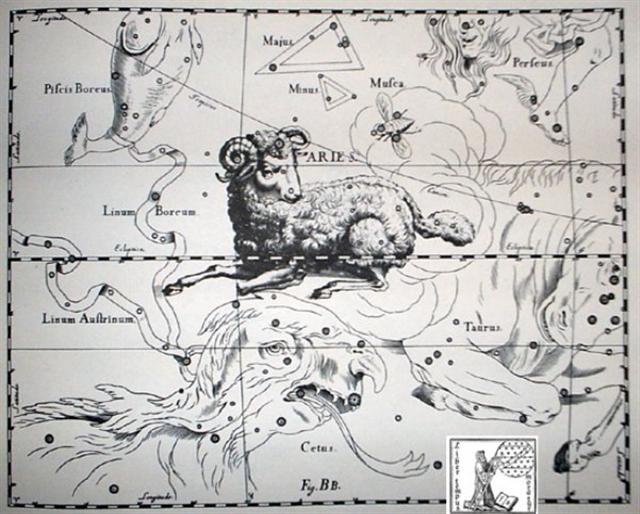 |
 |
| Cb1-6 (398) |
| ξ¹ Ceti (32.1) |
 |
 |
| Cb1-10 |
Cb1-11 (403) |
The question seems to be quite
complex and we have to move on. But before that we
ought to quickly take look at glyph number 220 = 377 -
157 = 393 - 157 - 16:
|
manu rere |
erima marama |
 |
 |
 |
 |
 |
 |
|
Ca8-16 |
Ca8-17 |
Ca8-18 |
Ca8-19 |
Ca8-20 |
Ca8-21 (220) |
|
CLOSE TO THE FULL MOON: |
|
Oct 22 |
23 |
24 |
25 |
26 |
27 (300) |
|
Al Ghafr-13
(The Cover)
/
Svāti-15
(Very Good)
/
TAHUA-TAATA-METUA-TE-TUPU-MAVAE-6
(a pillar to
stand by)
15 Bootis
(215.2),
ARCTURUS =
α
Bootis
(215.4),
ASELLUS
SECUNDUS
(2nd Ass
Colt) =
ι
Bootis
(215.5),
SYRMA (Train
of the
Virgin's
Robe) =
ι
Virginis,
λ
Bootis
(215.6),
η
Apodis
(215.8)
*174.0 = *215.4 - *41.4 |
ι
Lupi,
18 Bootis
(216.3),
KHAMBALIA
(Crooked-Clawed)
=
λ
Virginis
(216.4),
υ
Virginis
(216.5),
ψ
Centauri
(216.6),
ε
Apodis
(216.8 *175.0 = *216.4 - *41.4 |
ASELLUS
PRIMUS (1st
Ass Colt) =
θ
Bootis
(217.8) |
τ Lupi, δ
Oct.
(218.1), φ
Virginis
(218.7)
FOMALHAUT (α
Piscis
Austrini) |
σ
Lupi
(219.1),
ρ
Bootis
(219.5),
HARIS
(Keeper) =
γ
Bootis
(219.7) |
σ Bootis
(220.2), η
Centauri
(220.4) *179.0 = *220.4 - *41.4 |
|
CLOSE TO THE
SUN: |
|
April 22
ξ¹ Ceti
(32.1) |
23
χ Persei
(33.2), θ
Arietis
(33.3),
MIRA = ο
Ceti
(33.7) |
24
no star
listed (34) |
25 (115 →
Mercury)
ξ Arietis
(35.0), ρ
Ceti (35.4),
ξ² Ceti
(35.9) |
26
σ Ceti
(36.9) |
27
ν Ceti
(37.9) |
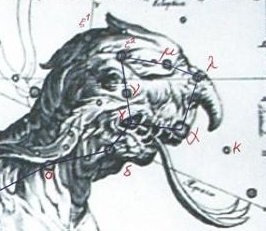 |
|


























